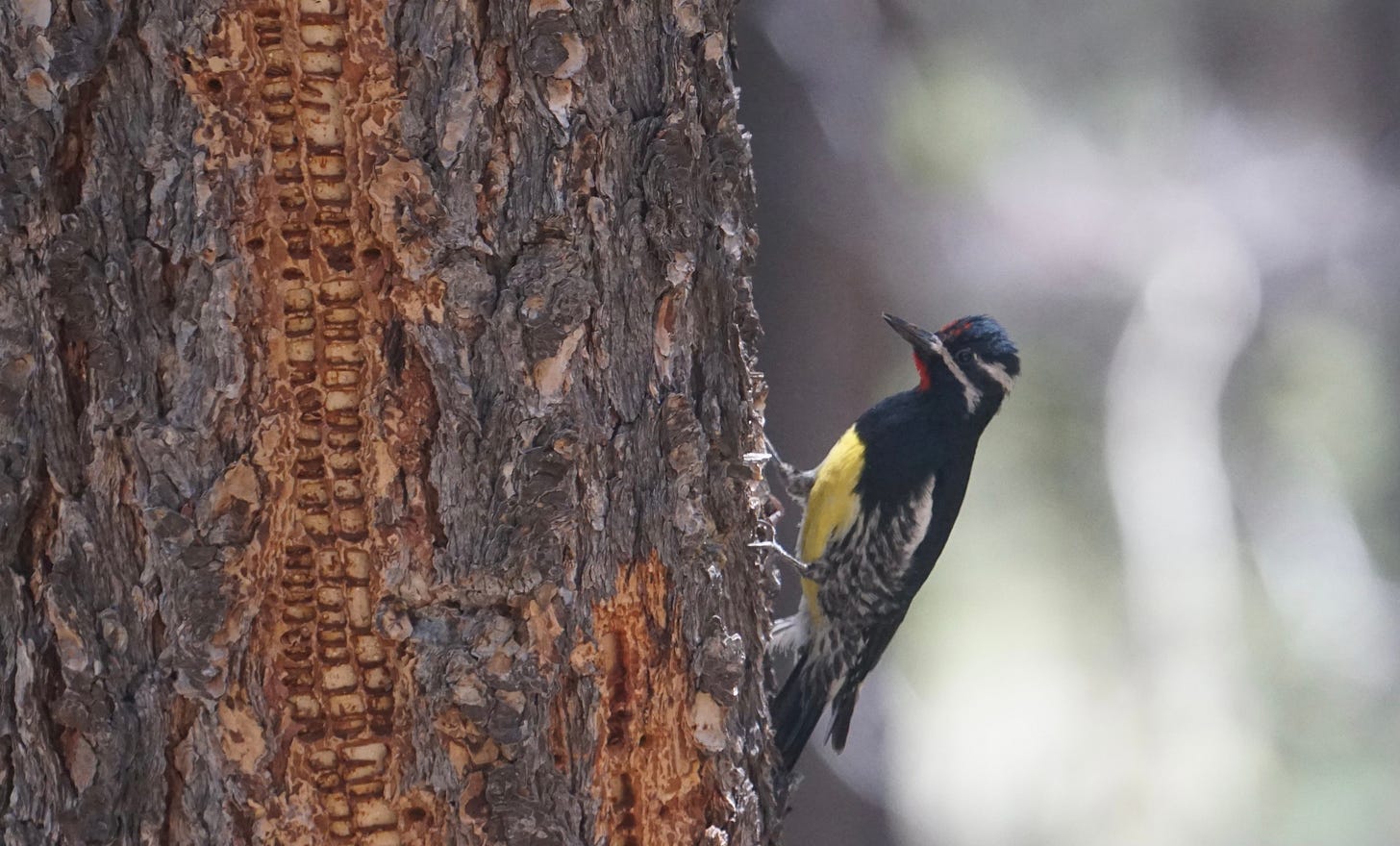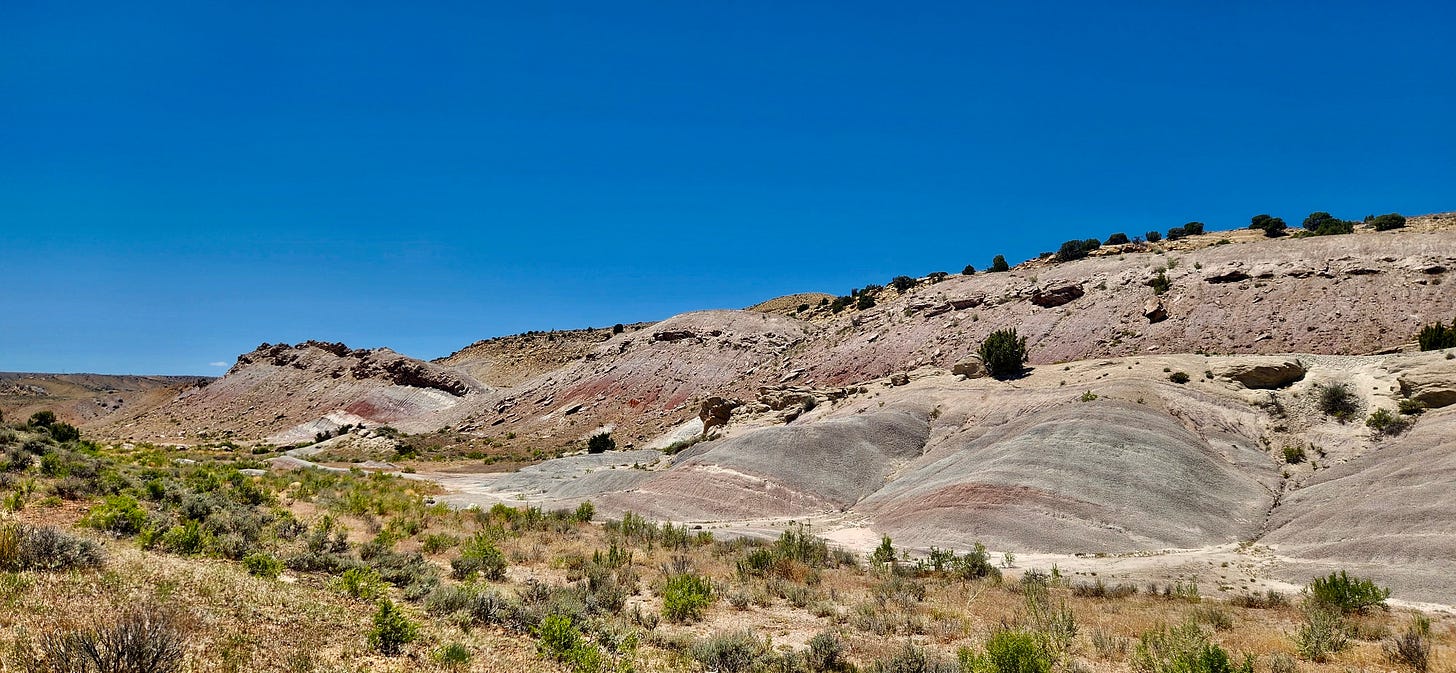This morning we decamped from the Roosevelt National Forest after three days under the mountainous stars just a stone’s throw from Rocky Mountain National Park. On the eastern slope, we stopped to walk in the lowlander sun, 90° and open skies. A pair of the locally uncommon Lewis’s Woodpeckers (Melanerpes lewis) sallied the gap between a willowed stream and the scattered pines, many of the pines remaining charred from the Overland Fire of 2003. With the sighting of the Lewis’s, our species total for the year is at 474, steadily on our way to our year goal of 500. It may seem like 26 more birds will be easy, but this is a moderately sized year, and surely not a big year.
One thing that has kept this from creeping into a mad-dash craze is the fact that we knew we would have some contract work peppering portions of the year. You have not heard from us in a while, possibly leading you to believe that too much camping, too much going to sleep feeling sticky-skinned from the day’s sweat caused us to pack it all in and move on to something more stationary. You would be wrong.
One of those contracts has come and went. We spent the days from mid-May until just last week cooking for a roving university geology camp. Our second time doing it, we met up with an amazing group of geologists/vulcanologists/paleontologists/friends, built a rudimentary kitchen in the back of a box truck, and set out for three sites around Colorado and Utah. Two of the sites have poor, at best, access to cell use and intrawave access, and one, in the middle of Bears Ears National Monument, a ninety-minute drive from Moab, has absolutely zero opportunity to connect with the outside world. All in all, the work is remote and the work challenges, but it challenges in the middle of landscapes that most would only dream of spending time in.
Though we had little opportunity to keep up on our year’s log, we surely continued to keep track of wildlife, flora and fauna, and many geological wonders, all in between preparing three meals a day using camping stoves and jet burners.
Easily, one of the best parts of doing these jobs is being around people who know a lot about things that we would like to know more about. The first site, at 8000+ feet, is volcanic in nature. The lead geologist described the terrain in detail, telling of how the San Juan Mountains are home to the largest volcanic flows in all of Colorado. Some 40 million years ago, eruptions created areas of composite rock 4000 feet thick. As you hike up through the forest from our campsite, you encounter an incredible array of Ponderosa Pine (Pinus ponderosa), Rocky Mountain Juniper (Junipers scopulorum), Douglass Fir (Pseudotsuga menziesii) and, my favorite, the Pinyon Pine (Pinus edulis) that the rich steely blue Pinyon Jay (Gymnorhinus cyanocephalus) needs to exist. And as you climb higher, the forest opens up into sunny clearings ringed by Mountain Chickadees (Poecile gambeli), Dusky Flycatchers (Empidonax oberholseri), Black Headed Grosbeaks (Pheucticus melanocephalus), and the altitude-preferring Williamson’s Sapsucker (Sphyrapicus thyroideus).

Along the forest slopes, exotic looking piles of volcanic rock, pancake-like in shape and oddly located, get cracked and squeezed by years of harsh weather and encroachment from budding conifers. These lapidary structures give a Fairyland wonderment to an already wondrous scene, and while we will never become rich doing this kind of work, it’s pretty hard to beat taking midday work breaks in a fairy forest overlooking the snaking Rio Grande.
At South Fork, we added eight new species to our year’s list, including Evening Grosbeak (Coccothraustes vespertinus), Cassin’s Finch (Haemorhous cassinii) and the charmingly chatty Clark’s Nutcracker (Nucifraga columbiana), all very much birds of upper elevations. We also tracked down the nesting pair of Dippers (possibly the same pair from our last visit a couple years ago) and watched them fly up to their nests to feed the screeching, open-mouthed young.
From the cold mountain air, we took the truck over the pass and eased our way down in low gear into the expansive arms of the desert heat. There is that first look of the colorful stratigraphies lying atop one another, holding in an ancient valley like omnipotent oracles. Church Rock, or “The Beehive”, guards the valley, ensuring the oracles keep their stony distance. While I lean towards cooler weather, the warm breeze moving across the empty road heading back towards Canyonlands National Park felt like a visit from a dear friend. A ten-mile drive off the main road passes through land stolen from natives and subsequently held for generations by invading cattle ranchers from the east. This year, the heavy rains have rutted the road, and twice we had to ford the high creek to make it to the BLM campsite. All very much well worth the effort.
Though the heat and the lack of showers and cell phone coverage can make it difficult to enjoy, particularly for the mentally dull or the perpetually uncurious, once you give yourself over to understanding how absolutely lucky you are to be in such a place, you feel a peaceful grace wash away the filth of modernity and the frustrations of modernly internal noise. The Wingate Formation gazes down like sandstone royalty, all gray and solid and ancient and wise; the rushing waters of the creek give life to miles of a majestic green Cottonwood seam, which in turn gives life to myriad birds, insects, flowers. A short walk along the trees, the creek opens into an oasis teeming with Black-billed Magpies (Pica hudsonia), Yellow-breasted Chats (Icteria virens), throngs of Warbling Vireos (Vireo gilvus) and Lark Sparrows (Chondestes grammacus). All of these birds return, year after year, to this isolated wonder of a place, tucked seemingly in the middle of nothing but grandeur. The birds sing; the lizards scamper; the cactus blooms shine against the desert floor.
Our third and final site kept the heat going, but graciously added an ever-present possibility of becoming a better person through learning. Dinosaur National Monument, northern Utah, just west of the Colorado border, came into being in 1915 to preserve the immense rock quarry wall filled with unextracted bones. Even a complete dullard has to stand in awe of seeing an Allosaurus skull and monstrous sauropod femurs held in time like Han Solo sealed in carbonite. Over 1500 bones preserved for us visitors, some 150 million years after these creatures were trapped in the Morrison Formation by a severe drought that led dinosaurs and their contemporaries to the river’s edge. Places like this allow us to paint a picture of the past so incredibly detailed. The plantlife, the animals, the general ecology of millions of years ago, the story. It is the story and the love for it that really gets these geologists going, and passing our afternoons outside of the Monument’s boundaries, scouring slopes of the Morrison searching out fragments of history is yet another benefit of a job like this.

We encamped at the Split Mountain group site, along the edges of where the Green River has been forging its way though the Permian Era Weber Formation for many, many an age. After a hot day of pulling pork and flipping pancakes, there is no better place in the world (seriously, the world) than sitting there at water’s edge, cold beer in hand, hundreds of swallows gleaning and swooshing, a Prairie Falcon (Falco mexicanus) alighting in waning sunlight on a ledge in the twenty odd stories of tilting rock.
After long days, particularly long-feeling as we neared the end of the contract, the students found their way down there to work on their mapping projects and to reflect. On the final night, after said maps were turned in, they stared up at the rock face across the rushing river at a film, Dune, projected across the way by the wonderfully youthful and the perpetually-excited-by-life logistics manager. Looking back over our shoulders on the way to the tent, early, as that film is longer than long, what a surreal photograph: a drive-in theater using an exquisite rock as the screen, moonlight, quietude.
Working has always been important in my family. We never had a ton of money, but we always had the ability to work hard to get it, if that was a goal we felt important. Of course money has its place, but in terms of importance it is rather low on the priority list. Being able to say this comes from a place of privilege, but work for me, as I have always understood it, is a means for a journey of discovery. It allows us to find some shelter; it allows us to eat some food; and, if appraised properly, it allows us time to look outwardly and to see how we want to appear inwardly. It would probably confuse people if they knew how much money The Ferry and I pull down per annum, but there is no secret to living joyfully below one’s means. If you work hard hardly working, you can carve out quite a life for yourself. Maybe it helps that I literally just changed into the Dysart’s Truck Stop tee-shirt I bought twenty-two years ago? Whatever the tricks, I am positive that a happy life comes from not buying a new phone every six months and from having your needs fulfilled more readily than your wants. Sometimes, if you play those proverbial cards correctly, the twain shall meet. Needs: putting some money in your pocket; Wants: seeing your curiosity sated by being in beautiful places with brilliant people. The twain shall meet.














What a wonderful world, my son you and Rachel look like you are enjoying every moment of your incredible journey
Love you love your life ❤️
I adored this entry! Smiling and smirking through it, knowing whose hand crafted those meaty observations. You definitely leave me longing for a beer by the river, especially in your company.
Missing you, dear friends!